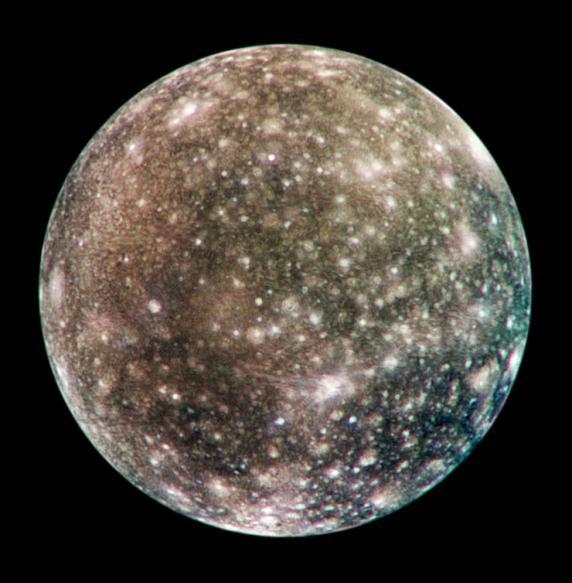Surface :
The surface of Callisto is dark and hence made of materials that contain little ice but very old. It has many craters indicating that the surface has not changed since the planet was formed. These craters are divers in size
(image 3).
The numerous white spots on the surface are due to ice rising from inside the satellite due to these impacts.
Callisto has a great impact basin
(image 2). The interior is shiny and is made up of ice that was radially ejected in the impact; it is about 300km wide. The outside is lined with a concentric mountain range that
was also erected on impact.
Meteorite impacts also have unexpected consequences seen nowhere else in the solar system:
parts of Callisto are covered in shiny spikes of 80 to 100 m high
(image 4). These were formed because of impacts and then eroded down. The erosion diminished the number of spikes but stopped some time over the course of history because
some little craters are still visible here and there. The spikes are made of ice and darker materials. In the erosion process,
the darker materials slid down to the ground to create the surface.
The surface now shows no tectonic activity.
| Distance to Jupiter | 1 880 000 km |
| Period of revolution | 16.65 earth days |
| Diameter | 4816,8 km |
| Mass (Terre=1) | 0.0180293 |
| Density (water =1) | 1.839 |
| Composition | Ice, rocks and maybe even metals |
| Albedo | 0.19 |
| Temperature on the surface | -172 °C |
|
Composition:
Callisto has the same composition as Ganymede (half rock, half ice) but its inner structure is probably not as distinguished.
Never the less, the presence of a global ocean is possible due to the induced magnetic field. The possibility of having liquid water without the required temperature
(neither a conducting nor a radioactive core) could be due to the existence of ammoniac in the water with would prevent it from solidifying.
The internal structure could therefore be the following: (images 5):
|
- an ice crust a few km deep...
- (possibly an ocean under the ice of a few tens of km deep)
- ...surrounding an interior made of a mix of rocks and ice.
It is also possible that the crust surrounds a coat of ice and rock and a core made of
silicates and iron
which could have a radius equal to half the radius of Callisto itself.
But the presence of this core is not at all certain.
